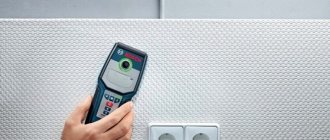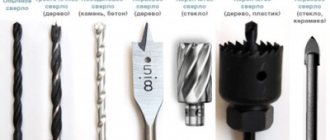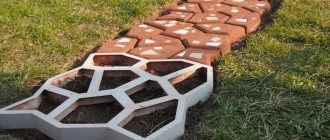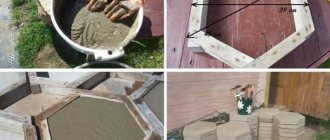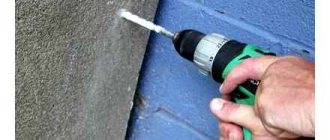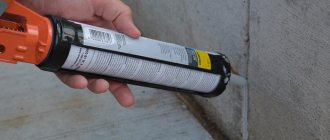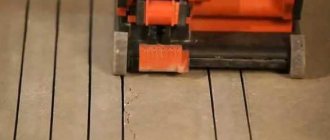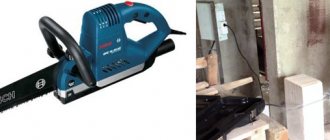The need to drill a hole in concrete can arise at any time - during repairs, laying communications, or when you want to hang a shelf or picture. The load-bearing wall is characterized by increased strength, and therefore drilling through it can be a difficult task.
To drill concrete walls you need a special tool Source bosch-professional.com
Necessary tool
The need to drill into load-bearing concrete walls arises regularly (for example, when repairing or installing electrical wiring, plumbing or furniture, such as shelves or an air conditioner), but this is not easy to do - such walls are much stronger.
A hammer drill is best suited for working with concrete. It is quite powerful and has a crushing function that breaks particularly strong pieces of the wall. The kit includes a set of drills of different diameters.
In some cases, you can use a simple drill to drill a hole in concrete. It is worth using if:
- You need to make some holes.
- The depth of the hole does not exceed 1.5 cm.
- You have to drill foam concrete - when using a hammer drill it crumbles.
In other words, a drill can be used if the amount of work is small and the holes themselves are small. But experts note that using a conventional drill will make drilling labor-intensive. Not just any drill will do - it must have an impact mode and pobedite bits.
Drill modes - drilling, drilling+impact, hammer drill Source rykinekruki.ru
You can also purchase a hammer drill - a more expensive but more powerful model.
The list of things to use to drill into a concrete wall also includes a screwdriver. But the model must be powerful enough and have durable attachments, and the concrete must be light.
Accessories for rotary hammers
Rotary hammers are designed for heavier construction work
Rotary hammers are excellent at drilling holes in hardened concrete.
They can also be equipped with various useful attachments.
The most popular type of chuck found on hardware store shelves today is the SDS-Plus chuck. SDS-Plus type drills have special grooves on the shank, due to which the drill is securely held in the chuck, but at the same time it can perform translational and reciprocating movements independently of the chuck. These drills are very easy to install and remove - no additional equipment is required. Some heavy-duty rotary hammer models use a similar clamping system, which differs only in its increased size - it is called SDS-Max. In addition, there are several brands that have developed their own clamping systems and corresponding drill bits, so when purchasing accessories, make sure that you buy an attachment that will fit your hammer drill.
A hammer drill operating in chiselling mode can be used to perform many types of repair and construction work, and in order to make this work easier for us, manufacturers have created a huge number of all kinds of attachments.
Possible equipment for the hammer drill includes various attachments for metal processing, chiselling, removing tiles, and even digging hard ground (in the picture on the left is a spade attachment for the SDS-Max chuck). In addition, you can attach a three-jaw chuck to the tool to use traditional drills.
Some of the most popular attachments are shown in the photo above:
- Earth Spade Attachment: Helps break up hard soil.
- Chisel for cold cutting: designed for chipping concrete.
- Tile Remover: Great for removing old ceramic tiles.
- Pointed chisel: This is useful for making pilot holes.
- Chisel: designed to remove rust, concrete deposits and splashes of molten metal.
If you already have a hammer drill and are looking to buy a powerful drill for drilling large holes, for example in wood, then we would recommend that you consider purchasing an SDS-Plus chuck adapter (shown in the photo below). This adapter will allow you to use cylindrical drill bits, hole saws and paddle mixers. The only thing is, do not forget to switch the hammer drill to drilling mode, otherwise the chuck may break.
Adapter for SDS-Plus socket. This adapter allows you to use your rotary hammer with cylindrical drills, hole saws and paddle mixers. Attention! When performing such work, the device must be in drilling mode, otherwise you will simply break the chuck.
Selection of nozzles
The correct choice of nozzles is extremely important. For work, special nozzles of increased strength are required.
The following types are used:
- Toothed bits for impact drilling.
- Diamond bits. Their edges have special cutouts and are coated with diamond chips or corundum. They are distinguished by increased strength (they even cut reinforcement) and accuracy: the surface of the hole is perfectly smooth. They work without shock.
Diamond-coated crown Source yunimag.ru
- KS-crowns. Their edges are coated with larger diamond particles.
When working with a drill, a punch may be required. This is a special durable pin that is used for crumbling concrete. Instead, you can use a pin, core, or even an old drill.
See also: Catalog of companies that specialize in the design and reconstruction of houses of any complexity
How to drill a large diameter hole?
Certain construction jobs may require large holes. For example, for mounting sockets, boxes for wiring distribution, ventilation. You can make several smaller holes and then combine them with a chisel, but in this case the hole will have uneven edges.
But there are situations when work must be done as carefully as possible. In this case, a special crown for working on concrete will come in handy. These nozzles differ in size. If drills are used frequently, they last a short period of time - durable materials such as reinforcing bars or granite cause them to break.
To increase the service life, it is worth initially making a small hole at low speeds. Next, the concrete and reinforcing bars are removed using a chisel and only then the holes are completed using the required crown.
Return to contents
Preparation and process
Before drilling into a concrete wall with a conventional drill, you need to inspect the tool, check its serviceability and insert the nozzle completely until it stops.
Then you will need to inspect the wall and check if wires and cables will be touched. If possible, you should also make sure that there is no reinforcement if you are using a non-diamond drill. If there may be reinforcement along the drilling path, it is necessary to prepare a metal drill.
Before you start drilling, you need to protect yourself: wear thick gloves, safety glasses, and insert earplugs or headphones.
Drilling a hole
First you need to mark the location and select the depth. Modern models usually have special limiters. If they are missing, you can put a mark on the nozzle.
A few examples will help you better understand how deep you need to drill: for a picture or a light shelf, 2.5 cm deep is enough.
Drilling with special attachments Source minemegashop.ru
When installing the dowel, the hole should be several millimeters longer. When the dowel is inserted, dust will form, which will take up extra space.
A hole is drilled in a brick or concrete wall in several steps:
- Having chosen a place and made a mark, attach the tip of the nozzle and turn on medium speed without turning on the impact mode.
- After passing a few millimeters, you need to increase the speed and turn on the shock mode. This will allow you to continue drilling smoothly without deviating due to strong vibrations.
- Every 10-15 minutes you need to stop and let the engine cool. You can continue only when the tool has completely cooled down.
- If desired, the nozzle can be regularly moistened with water so that the metal does not bend or overheat.
Working with a punch will require more time and labor. The tool itself is necessary when the wall is too hard and the drill cannot cope.
Using a limiter Source mebel-expert.info
Video description
This video shows how to drill a hole with a hammer drill with a diamond bit:
Diamond drilling is done in 2 ways - dry and wet. In the second case, when drilling, water constantly flows onto the working surface. It cools the drill and reduces noise; dust settles in it. However, if electrical wiring runs nearby or constant access to water is not possible, the dry method is used.
Diamond drilling produces smooth holes Source kas.kz
Useful tips
The drilling process is simple, but it requires certain dexterity and skills. It is important to keep the tool level so as not to displace the drill and increase the load.
Some tips will help simplify the work and make the hole in the wall neat:
- You can't skimp on drills. Poor quality attachments break and bend easily.
- You can determine the presence of fittings with a metal detector.
- When installing the dowel, the hole should be several millimeters longer than the fastening. These extra millimeters will be clogged with cement dust when the dowel is inserted.
- If it is necessary to make a through hole, at the end of drilling, when approaching the opposite side, the speed must be reduced. This will help prevent the concrete from chipping.
- When using a low-power drill, it is important to regularly, every 10-15 minutes, stop and cool the motor. This will help prevent damage to the instrument.
- When drilling, it will be dusty, and therefore, before drilling into a concrete wall, it is better to prepare a vacuum cleaner. It is better to use a construction vacuum cleaner, since household models will quickly deteriorate from small crumbs.
When drilling, a lot of dust rises Source waysi.ru
Sometimes the nozzles get stuck in the block. They should not be pulled by force, as they can easily break and leave a piece in the wall forever. You need to disconnect it, attach a smaller nozzle, and drill into the wall nearby.
Errors when working with a drill
Some errors when using a drill can cause poor quality work, tool breakage and injury. When drilling, do not hold the tool by the chuck. If your hand slips, it will be damaged by the drill. You only need to hold the device by the body and the special handle.
Work only with tight gloves. Fabric versions can easily become caught in the chuck and become twisted during rotation, causing injury. It is not recommended to press the drill too hard when working. In this case, there is a high probability of loss of coordination and falling, as well as breakage of the drill. It is unacceptable for a person’s hand to be on the back side of the concrete surface, because the drill bit may penetrate through and cause serious injury.
Briefly about the main thing
To drill a hole in concrete, use a powerful drill or hammer drill.
The bits must be strong enough to penetrate the stone without getting damaged. When working with walls that have reinforcement, you will need a metal nozzle.
Before you start drilling, you need to check whether there are any wires or pipes running inside the wall. It is also advisable to make sure that there is no reinforcement.
The process itself is simple and requires only care and skill. The main thing is not to overheat the tool’s motor and make sure that the drill does not go to the side.
